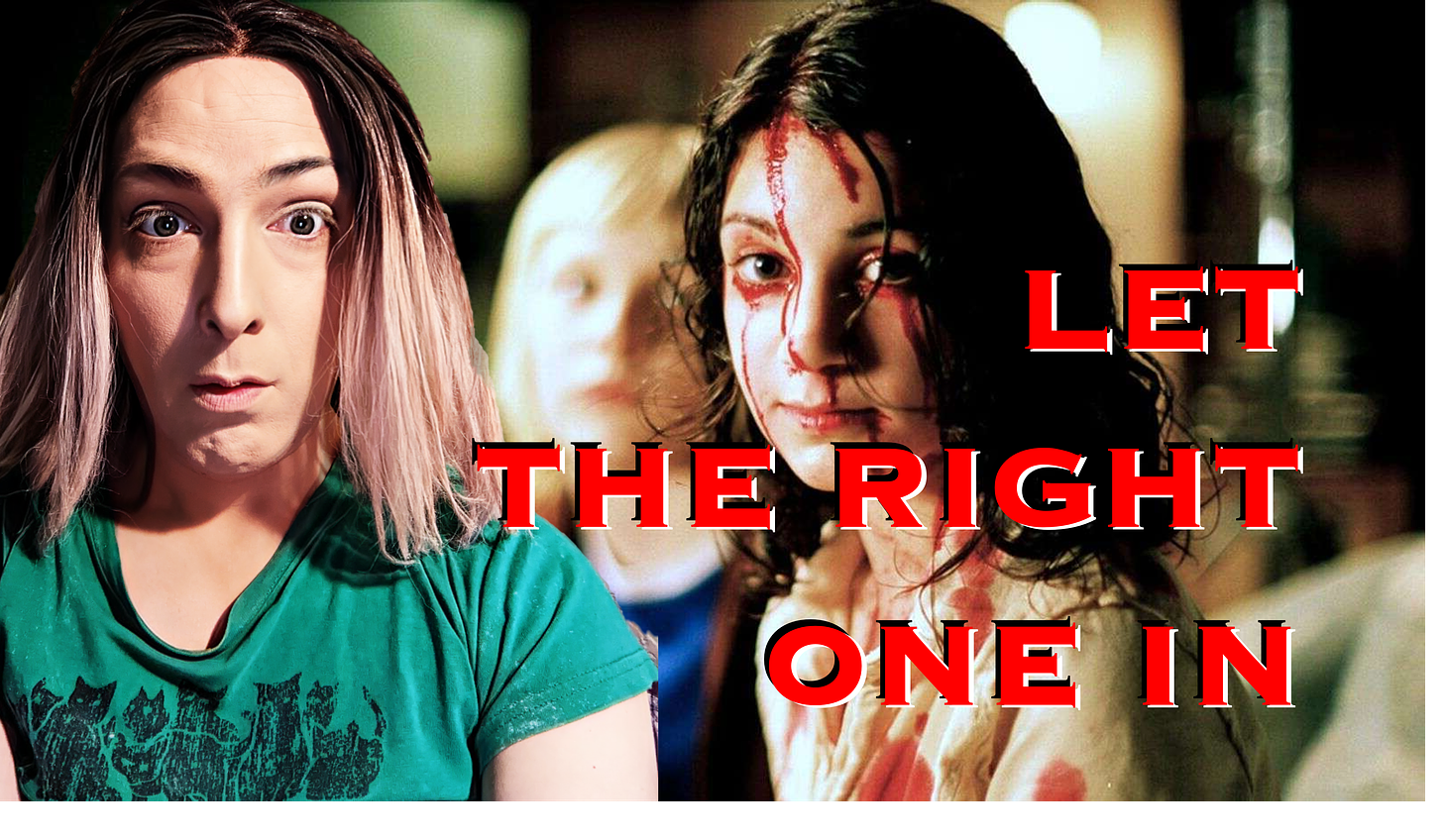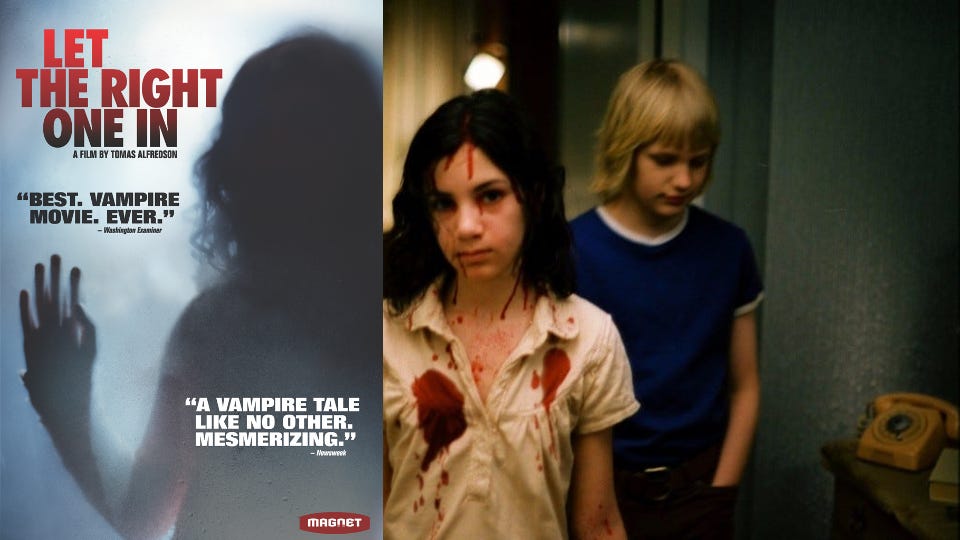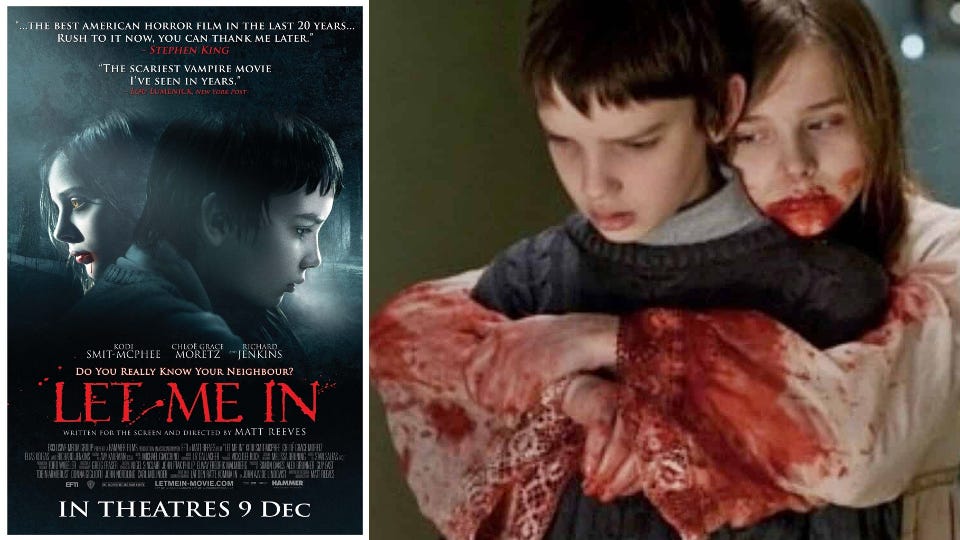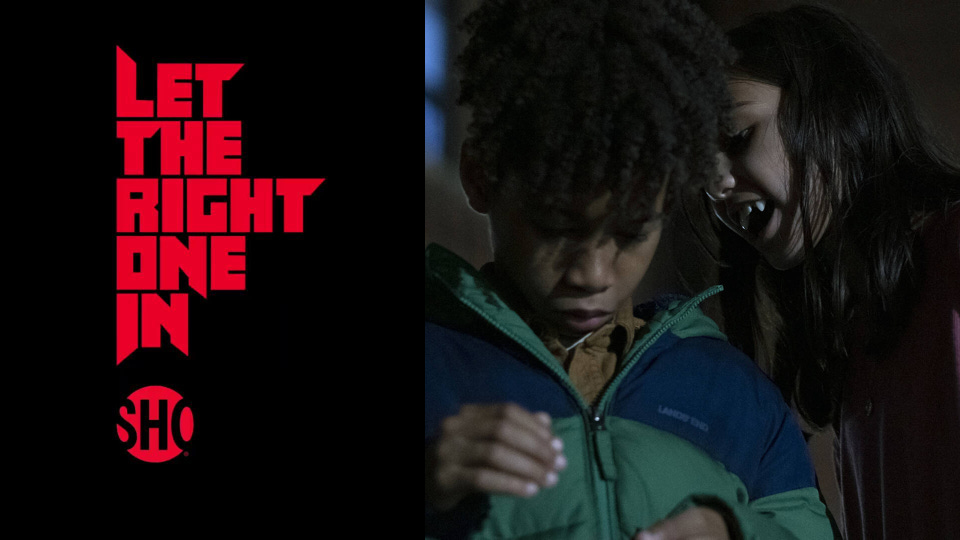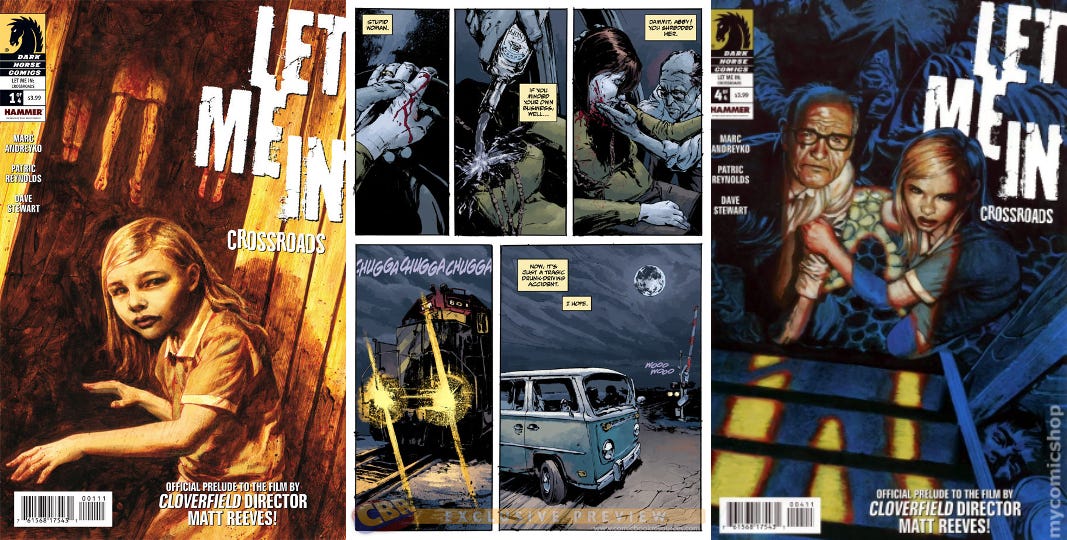The Queer History of 'Let The Right One In'
Answering Whether The Vampire From 'Let The Right One In' Is Cis, Trans, or A-Gender
Let the Right One In deserves its status as a horror story classic—but more than that, as an inspiration for queer audiences. The simple premise is that amidst a series of grisly murders in a small town, a twelve-year-old boy falls in love with a childlike vampire.
What few people realize, however, is whether the vampire is a cis girl, a trans girl, a gay boy who merely presents as a girl, or an a-gender vampire who is off the spectrum altogether. It’s no one’s fault for missing a clear answer—because the answer has changed for every new adaptation.
Let’s deep dive into each version of the story and why the answer changes each time.
NOTE: If you haven’t seen the original movie, it’s streaming for free on Tubi
Is the vampire in Let the Right One In transgender or not?
Seven different adaptations get seven different answers.
The book? No.
The original movie? Maybe.
The American remake? No.
The Showtime original series? Nope.
The stage play? Nope.
The other stage play? Yep.
The comic book? Oof — denounced by the author — but as its own thing…?
Let’s break down why the answer changes for each adaptation, as well as why each answer empowers queer people in its own way.
Plus—a glimpse at the long-awaited short story sequel from the author John Ajvide Linqvist, which reveals the fate of the star-crossed duo Oskar and Eli.
Let the Right One In: the Original Novel
The original novel was released in 2004. From the artist Bud Cook’s New Edition with incredible illustrations, here’s the premise that first hooked readers:
Lauded by critics as “brilliant and repulsive,” Let the Right One In by John Ajvide Lindqvist is one of the most acclaimed and adapted vampire novels of the 21st century.
In the autumn of 1981, the body of a teenage boy is found drained of blood in Blackeberg, the Swedish suburb where twelve-year-old Oskar lives. Bullied frequently by his peers, Oskar is a social outcast who becomes fixated on Eli, the new girl who has moved in next door. To Oskar, there is something strange and wondrous about Eli, the girl who has never seen a Rubik’s Cube but can solve it within hours. The girl who only comes out at night. The girl who smells of death.
With its themes of existential anxiety, social pressure, and the complications of youth, Let the Right One In is a gory vampire tale, a stirring love story, and a profound meditation on childhood love and loneliness.
The novel was originally published in Swedish, then translated into English. On first glance, moving from Swedish to English could mean the narrative lost a nuance in the language that couldn’t survive translation, but it turns out Swedish audiences were just as confused whether Eli was a girl, a castrated boy, or a creature who has no gender.
Fortunately, a brief but essential scene in the novel clarifies Eli’s nature. Writer and critic Vrai Kaiser summarized the pivotal scene, saying:
The book makes it explicit that Eli is not trans. He is a forced eunuch. A boy.
At one point in the novel, when the two are alone, she willingly reveals her naked body to the overwhelmed Oskar. She is described as basically having no genitalia, having a scrawny body with long limbs and zero curves. He asks what happened to her penis. She makes an awkward joke that she left it on the subway! Oskar is confused but laughs along with her.
In a 2008 interview, author Lindqvist stated, “Eli is supposed to be a boy, a castrated boy.” After Oskar sees her genitals, he worries he’s a “fag” which he is called by the bullies at school and now, because he’s in love with a boy, it’s come true.
Please note that in the novel, once Eli reveals their true backstory, their pronouns on the page switch from she/her to he/him.
That backstory comes in a second brief scene in which Eli tells the story of how they were changed into a vampire—and why he presents as a girl. Turning now to a wonderful YouTube review by non-binary media critic Maven of the Eventide:
In the book, Eli was a little boy, and hundreds of years ago, he lived in this place where every so often the local vampire lord required the people to bring sacrifices of children to him. Eli was the most beautiful little boy in his village, so of course he got chosen to be the sacrifice. And him and a bunch of other kids got sent up to the horrible vampire lord, and the vampire lord picked Eli.
He takes Eli and chops off his penis and everything, and then turns Eli into a vampire. And that's Eli’s vampire origin story. Later on, 200 years later, he's still living.
I don't know where the vampire lord is or any of that other stuff, but because [Eli] is such a beautiful little boy and doesn't have any genitals, he dresses like a girl and passes himself out as a girl, and it's mainly because when you look like an innocent little girl, people [are] like, “Oh little girl, can I help you?” And then you can jump on them and bite their neck. But if you look like a little 12-year-old boy, people are like, “Get out of here, ruffian. Kids, get off my lawn.”
So he presents himself as a girl as a way to trick people, and you know, get victims better. But when Oscar is sort of having his first pre-teen crush on Ellie, he's never been into girls before. He's just, like, not like prepubescent, but he's getting his first crush on Eli.
Eli keeps being like oh, this is bad, he thinks I'm a girl. I'm not a girl. But he never says I'm a boy. He says, “I'm not a girl,” because he's a vampire. As in, “I'm not this child you think I am. I’m an ancient being.”
[Oskar’s] like oh, you're a boy. Does that make me gay? I guess I'm gay. And then he goes and he talks to his teacher about that, and his teacher is like, oh, it's okay to be gay.
Let’s go one step deeper and look at how the book was received by another trans reader. Instead of looking directly at the review for the book on Tor.com, we’re digging into a piece of insight dropped into the comments for that review.
Way back in 2010—practically eons ago—“crazychristina” left a comment on a Tor.com review, saying they felt the author specifying Eli as a castrated male was a mistake that did not serve the story. In their comment, crazychristina wrote:
[The twist] doesn’t explain anything, advance the plot in any way, or even shed significant light on the characters except perhaps to show that Oskar wanted companionship rather than a specifically ‘romantic’ relationship.
crazychristina said that specifying Eli as a castrated boy “raises a lot of questions that are not further addressed,” particularly as progressive people are likely to see a person’s gender as having nothing to do with whether they wear dresses.
Non-binary film critic Maven noted that Eli actually being Elias also puts the story under a transphobic gaze, saying:
You know, when the author was writing it, he wasn't aware of the harmful tropes of trans women are just a man in a dress trying to prey on people to get into women's bathrooms to rape women… So him making Eli a boy in a dress was because it's easier to prey on people, [but] he wasn't meaning to feed into that trope. But it did, against his intentions, so you know, make of it what you will. Culture in Sweden is very different than culture in America, so you have to take consideration too, I think, that he meant well. I don't think he meant anything harmful by it at all when he was writing it.
Now let’s see what happened the first time the novel was adapted for film.
Let the Right One In: the original movie
Released in 2008 and directed by Tomas Alfredson, the Swedish film adaptation quickly rose to cult status. The late film critic Roger Ebert called it “the best modern vampire movie.”
In 2021, national best-selling author Torey Peters brought her insight on transitioning (and de-transitioning) onto the film Let the Right One In, saying:
The first time I watched Let the Right One In, I was transfixed, and just kept on saying to my friend: "I didn't know I liked horror films, but wow, I guess I do," and then there came an ambiguous moment, an intimation (no spoilers), that perhaps the vampire is trans.
A few key changes expanded the interpretations of Eli’s gender.
Writing for Skip the Makeup, media critic and trans woman Gina described a pivotal scene in the movie, saying:
In the Alfredson film, Oskar instead sneaks a peek at Eli while she’s naked (she’s just showered off a large quantity of blood) and sees a quick glimpse of what seems to be the crude results of a penectomy/castration but not typical female genitalia (and granted, the rather insular Oskar probably doesn’t know what typical female genitals look like). The Swedish film has Eli played by the haunting amateur child actress Lina Leandersson, who has a powerful presence and pathos in this role. She looks like pre-teen version of Joan Jett who’s been living in filth and malnourishment for the past year (or is it 220 years?).
Curiously, the director, at the author’s instigation, had the young actresses’ voice dubbed at the last minute because they thought it was too high and wanted it to sound lower and more androgynous. The final effect is that of someone who’s seemingly sexless both from her addiction (blood) and her inability to properly take care of herself. There is never any mention by Oskar about his concern for being moony over a “boy” but given rapturous responses I’ve heard from moviegoers of all genders, it’s hard to see the film and not find yourself with a crush (or, at least, extremely maternal/paternal) towards Eli/Leandersson.
Deleted scenes of flashbacks would have further clarified why Eli appears as a girl—but the director chose to remove these scenes, leaving the question of Eli’s gender open to a wider place on the canonical spectrum.
The final scene of the movie shows Oskar and Eli escaping together on a train. Unable to survive in daylight, Eli is inside her portable box coffin, but she isn’t asleep. She speaks to Oskar by using Morse code. And in a perhaps crude coincidence, Oskar taps back on the box, spelling out P-U-S-S, which means “small kiss” in Swedish.
Let Me In: the American Remake
The American remake received lavish praise from Roger Ebert and Stephen King, with the latter calling the movie “a genre-busting triumph.” But when it came to queer audiences—and one British film critic—Let Me In received a far more lukewarm welcome. And there’s nothing worse than lukewarm blood.
Film critic Mark Kermode expressed just what made the remake so lackluster, saying:
“The original is a film about children that happens to have vampires, the remake manages to be a film about vampires that has children in it”.
“The central thing about the original film was that it is all about being an outcast, the anger and the rage of childhood”
“Let Me In tries to reconfigure this for the Twilight audience”
The American remake—as is too often the case—removes the nuance of the novel and Swedish film adaptation. Helmed by celebrated director Matt Reeves, the remake instead presents Eli, now named Abby, as having always been a girl. The clarification comes from a deleted scene showing when Abby was turned into a vampire centuries ago, as well as a revisiting of the “Crying Game” scene in which Oskar, now named Owen, discovers the gendered (or genderless) nature of the vampire.
Gina, author of the trans blog Skip the Makeup, offers this breakdown when comparing the book to both movies. She made three crucial points, saying first:
In the new Reeves version, they just show a reaction shot of Owen’s (the American version of Oskar’s) face when he looks at Abby (the American name for Eli) naked in the bathroom and, basically, don’t show anything. From the audiences’ lack of reaction, I’m assuming they had no idea why he had a look of surprise on his face. Later in the film, Owen asks Abby, “If you’re not a girl what are you?” She replies, “I’m not really anything.”
After seeing both films, I can honestly state the recent remake is a slick, cliched imitation of Alfredson’s original film which is an elegiac masterpiece about loneliness and addiction (and actually far more frightening than the remake). But what is especially interesting is to see how Lindqvist’s trans-related themes, which run strongly throughout the novel, get differently digested (and edited) in the two subsequent films.
Second, Gina went on to note:
Along the way, in all three versions, Eli and Oskar haltingly become close — two outsiders who’ve found each other. At one point (also in all three versions) they hug and she shyly asks, “would you still like me if I weren’t a girl?”
When I saw [the] original film, “Let the Right One In,” it was at the Castro Theater in San Francisco. No one reacted to this line. When I saw the remake “Let Me In” it was at a multiplex in a suburb south of San Francisco and the same line elicited big laughs.
In the book we find out (by way of a tender fable Eli tells someone she’s about to suck dry of their blood) that she was the youngest, very beautiful boy in a poor family. Because the boy was small and not very useful for farmwork, he was given up to a nearby lord (who presumably made him into a vampire).
In the book, Eli continues to ask Oskar for his feelings about someone who isn’t the gender she seems. She ultimately tells him her name was formerly Elias. He obsesses more over the fact she used to have a boy’s name than the fact that he’s now figured out she’s a vampire who has been responsible for many local deaths.
The remake, however, removes any possibility for this nuance.
And finally, Gina also commented on the transphobic implications of another key change to the remake.
The actress playing Abby (professional child actress Chloe Moretz who made a big splash in the film Kick Ass) looks far more female and more girly in this version of the story. She’s still without curves and, at certain points, I swear they padded her shoulders to make her look more male-bodied. But Moretz is a pretty girl who, with the right makeup, might look like a standard issue teen model on the cover of 17 Magazine. Needless to say, it pretty much ruins the impact of the character and buries the entire gender thread from the novel.
The changes didn’t stop there. The film went on to add a scene that evokes transphobia without letting the character be trans. Gina describes the scene, saying:
In a somewhat bizarre scene from the English language remake, Owen, listening through his shared bedroom wall into Abby’s apartment, can hear muffled sounds of Abby berating “The Father” (as Håkan is called in the English version) using a voice which sounds like an adult male. This scene isn’t in the book, so it’s an invention of the director’s… obviously as a way of bringing out some sense of Abby really being an adult male. It happens twice in the film and then isn’t repeated while we can actually see her. It seems to have an undercurrent of the “born a man” line which trans women [often] get tossed at them.
So much of the Eli’s outsider status comes not just from her addictive need to drink human blood, but because she’s basically a trans girl (or perhaps a forced eunuch like David Reimer?) who is incredibly insecure about how people see her and what she offers the world as a girl — mirroring Oskar/Owen’s owns insecurities about his masculinity. In the Alfredson film which, although it edits down this thread from the book, I still think it would be impossible for a trans person to see this version and not have it profoundly resonate with them. In the English film version, so much of this powerful character revelation has been whitewashed.
In a discussion with a poster commenting on her review, Gina remarked on how deeply the American remake diluted the queer empowerment of the original story, as well as why despite lavish praise from critics, close similarities in the cinematography and mise en scène of both films made the remake look and feel redundant.
Oskar/Owen is quite different from the book in both films. He’s supposed to be chubby and very angry. Like, potentially violent angry, and fairly asocial in the book. Neither film version really portrayed him that way. I didn’t see Owen as being at all androgynous in the English remake, but he was a delicate boy. I think Oskar in the Swedish version is more likable than he is in the book, but he’s also far more ‘disturbed’ than in the English film. Other than perhaps laying shoulder pads on the girl playing Abby, I saw little attempt at trying to keep her ID in the book as a castrated male and she looks a good deal more “cute female” than Eli does in the Swedish version.
Matt Reeves could have made a film that was far more based on the book, but he didn’t (despite his claims). Much of Let Me In is shot for shot like the Swedish film (eg the ending). Basing it on the book would have made for a far more disturbing and interesting film than the product he put out (and a LOT more involvement of trans and pedophilic issues). As it is, Let Me In will vanish into mediocre film obscurity while Let the Right One In has become a classic.
Writing for Tor.com, film critic Lee Mandelo took aim at just how far the remake missed the mark, saying:
I will very briefly get on my soapbox about the thing that made me the most irritated about Let Me In: the decision to erase the issues of gender and sexuality from the film…
It’s the idea that American audiences are too prejudiced and too queer-phobic to deal with those topics in a movie. Admittedly, that’s probably correct, but it was still caving in on an issue that the director had the opportunity to work with. Hell, he could have chosen to make it even more obvious and actually deal with the questions of sexuality! Instead, he retreats to a comfortable hetero-normative position.
Lee Mandelo continued their commentary in the comments for their article, replying to Brian C. by saying:
Yes, they do re-use the “I am not a girl” line. The difference? Oskar’s answer is that he would still like Eli. Owen’s answer is “but no, I guess not.”
Really, really big difference. (Also, there’s way more than just the scar-scene in the original. Eli’s voice is deeper than a normal young girl’s, no breasts at all, ambiguous facial structure (which was achieved with intentional makeup, the actress herself is very feminine and round of face out of character), even at some points ambiguous clothing, ESPECIALLY in the beginning.
Let the Right One in: the Showtime Original Series
The Showtime original series adaptation makes three crucial changes to the adaptation. First, the series moves from a snowy desolate town in Sweden to the big time of New York City. Second is that the childlike vampire is now an actual child recently turned into a vampire. And third—most important to our question—is that the vampire is very clearly a cisgender girl.
In her wonderful YouTube review and comparison of several adaptations, non-binary film critic Maven of the Eventide describes the changes to the Showtime series, saying (16:54):
Yeah, Eli, Eli, Ellie, whatever you want to call it, is like 200 years old in the book. In this, she's like 20 years old, so her dad, when she was 12—so like 15 years ago—she got turned into a vampire. And part of the reason they move around a lot is because they're trying to find the vampire who attacked her and find this guy and get him to cure her
They are convinced if they find the vampire who attacked her, they can get the vampire to cure her, so they've been kind of like chasing murder sprees around the country. And every time they think they find, like, oh that must be the vampire doing his murder thing again, they move there.
And so the dad really wants Ellie to have a place where she can settle down and just have like a normal life. And this is really important, he really wants this for her, and he's been promising her this. And he's like look, we'll actually get furniture this time in this apartment.
Let the Right One In: the Stage Play Adaptations

There have been no less than four stage play adaptations for Let the Right One In. They’re all fantastic, it’s almost a guarantee, but it’s the fourth one from 2022 that demands our attention.
Why?
Because it’s the first adaptation of the story to make Eli explicitly a trans girl.
A rave review from The Guardian says:
And by casting Thornton-Walker, a trans woman, as Eli, the production stretches out the queer-as-in-strange allegory of their connection, previously only hinted at in other adaptations by Eli’s insistence that they are neither girl, boy or vampire, just Eli. These two characters find connection in shared weirdness and a capacity for great violence – but is it a survival tactic or an irresistible, monstrous desire?
Directed by Alexander Berlage, Let the Right One In explores the lengths we will go for love and the power of connection. Will McDonald’s Oskar is youthful, naïve, and charming. His comedic timing alongside Thornton-Walker’s Eli had the audience at times in stitches, bringing much needed light to an otherwise darkly themed show. Thornton-Walker’s physicality as Eli is also something to behold, she is deft and agile, leaning into the odd and mysterious but intelligent and empathetic nature of her character.
A glowing review from CityHub commented further on the casting, saying:
To prepare for their respective roles, McDonald went back to source material, especially the book, but ultimately relied on the script itself; Thornton-Walker, who is trans, already felt an affinity with Eli, and used much of her own life experience to inform the character.
A review from Time Out offered their praise for Thornton-Walker as well, saying:
Thornton-Walker is fantastic as Eli, her physicality and demeanour managing to evoke an unsettling mix of child-like innocence, playful seductiveness, loneliness and danger. There are striking, stark moments of horror that see her streaked in blood or gliding ethereally through a fog bank. As a trans woman, Thornton-Walker’s casting is also particularly provocative here. Although only alluded to in most adaptations, in the source novel Eli was a boy, Elias, in mortal life, but identifies as female as a vampire.
Let the Right One In: the Comic Book prequel
There’s not much to add about the comic book adaptation from 2010. The story is a prequel to the American film remake Let Me In, and so it falls prey to the same lackluster queer representation as the American film proper.
It’s also worth noting that the author of the novel was furious over the comic book adaptation. Apparently, he was unaware just how much of the rights for adaptation he was signing away when he agreed to first adapt his novel.
Let the Old Dreams Die: the Short Story Sequel
The short story sequel provides a continuation and conclusion that feels as surprising and yet inevitable as the original novel.
In a review for Tor.com, book critic Niall Alexander wrote:
Let the Right One In is a love story, of course, and in “Let the Old Dreams Die” — the short Lindqvist’s first collection takes its title from — we get a glimpse of what happened to the young couple after the blood-curdling curtain came crashing down.
Lindqvist isn’t content, however, to simply pick up where he left off. Instead, he circles the fate of Oskar and Eli from another angle entirely. Like Let the Right One In, “Let the Old Dreams Die” is “a story about a great love,” but not necessarily the one we expect. Rather than return to Blackeberg and the bloody mess Oskar and Eli left there, it takes place many miles away, and many years later. The events of the book and the movie are at least long gone, if far from forgotten…
The unnamed narrator of “Let the Old Dreams Die” is a stoic public servant who grows old alone over the course of what is a ridiculously ambitious narrative, which aims to take us in approximately 30 pages from the early 80s of Let the Right One In through to late 2008, in addition to telling three distinct tales in that short space: his, Karin and Stefan’s, and of course Oskar and Eli’s…
“Let the Old Dreams Die” is no simple sequel, and if the truth be told, I don’t know that I’d have wanted one of those. Instead, what we have here acts as an affecting post-credits snapshot, and tells a tale that would be touching and tragic and timeless even if it didn’t have anything to do with the book and the movie that made John Ajvide Lindqvist’s name.
The End
That’s all this time for us from Queer History. Please like, share, and subscribe. If you have a few dollars, please consider becoming a paid member of our Substack or Patreon.
Until next time!
Other links
Stephen King review: Let Me In “the best American horror film in the last 20 years”
Let the Right One In and Oskar are compared to Mio’s Kingdom
Let Me In: Krell Laboraties Review
Tranquility.net review of Let The Right One In
The 5 Biggest Differences Between Let Me In And Let The Right One In (CinemaBlend)
Ebert’s Review 1: Let the Right One In
Blood on the stage: Let the Right One In is a vampire love story for our times
Let Me In should NEVER have been made (Twin Perfect video essay)
Ebert’s Review 2: Let Me In
NYCC ’22: Showtime’s LET THE RIGHT ONE IN brings child vampires to New York City
Let the Right One In: How the Showtime Series Will Compare to Films (MovieWeb)
‘Let the Right One In’ Series vs. Movie: Which One Is Right for You? (Indiewire)
Let the Right One In Review: An Expansive Adaptation With a Big, Bloody Heart
Let the Right One In TV Series Will Include Multiple Vampires
‘Let the Right One In’ Cast Explains That Premiere Shocker & Hunt for Vampire Cure (VIDEO)
Interview: ‘Let the Right One In’ Explores Human Struggles In a Vampire Story
Dark Horse May Not Have Been The Right One to Let In (before publication)
LET THE RIGHT ONE IN AUTHOR FURIOUS OVER COMIC BOOK ADAPTATION
Review in Swedish of a stage adaptation in Australia




